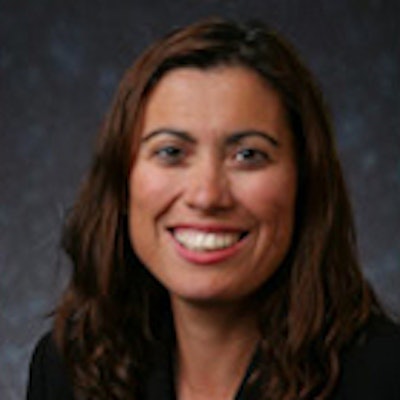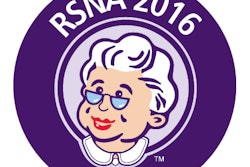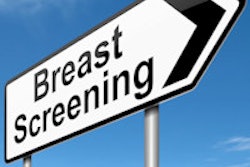
On April 20, the U.S. Preventive Services Task Force (USPSTF) issued updated draft guidelines for mammography screening. Among other recommendations, the guidelines state that evidence is insufficient to determine the benefits and harms of screening mammography in women 75 and older.
But if women are healthy and without other disease, why shouldn't screening continue? It should, according to a presentation given at the recent American Roentgen Ray Society (ARRS) annual meeting in Toronto.
"Census data show us that women are living longer," said session co-moderator Dr. Stamatia Destounis, of Elizabeth Wende Breast Care in Rochester, NY. "And if they're healthy, they're still good candidates for regular screening."
 Dr. Stamatia Destounis of Elizabeth Wende Breast Care.
Dr. Stamatia Destounis of Elizabeth Wende Breast Care.Women older than 65 represent a significant number of the annual total deaths from breast cancer, Destounis said. She cited American Cancer Society (ACS) surveillance research that estimates there will be 231,840 breast cancer cases and 40,290 deaths this year in the U.S. In women 65 and older, 99,590 breast cancers will be diagnosed and 23,280 women will die from the disease -- 58% of total breast cancer deaths.
Data from her own facility show a similar trend, according to Destounis.
"Last year we found 376 cancers through screening, and 60% of those were in women 60 and over," she said.
So when should breast cancer screening stop? Destounis outlined guidelines from the American College of Radiology (ACR) and the Society of Breast Imaging (SBI).
"ACR and SBI suggest that screening stops being beneficial in women whose life expectancy is less than five to seven years, due to age or comorbid conditions," she said. "Or when abnormal results from a screening mammogram would not be acted on with diagnostic workup, biopsy, or even surgery -- due to a woman's age or comorbidities."
Older women's whole health picture should be considered when it comes to breast cancer screening, Destounis concluded.
"Our responsibility is to consider this population carefully and image accordingly," she said.
Still plenty of cancer
In a scientific presentation given during the same ARRS session, Dr. Maya Hartman, of NewYork-Presbyterian Hospital, shared findings from a study she and colleagues conducted to determine the incidence of breast cancer and its associated histologic and prognostic features in women ages 75 and older. The study was also published in the May edition of the American Journal of Roentgenology (Vol. 204:5, pp. 1132-1136).
"Before 2009, USPSTF had acknowledged that there might be a lack of data about screening mammography in the elderly population, but said there was every reason to believe that benefits observed in younger women would likely apply to older women as well," Hartman told session attendees. "That changed in 2009. But in any case, the American Cancer Society and the American College of Radiology have continued to recommend annual screening starting at age 40 and continuing for as long as a woman is in good health."
For their study, Hartman and colleagues reviewed 68,694 screening mammography exams acquired between 2007 and 2012. Of these, 4,424 (6.4%) examinations were performed on patients ages 75 years and older; based on these exams, 64 biopsies were recommended and 60 were performed.
From the 60 biopsies, 26 breast cancers were found, for a breast cancer detection rate of 5.9 per 1,000 screening examinations and a PPV2 (positive predictive value for cancers detected after a biopsy was recommended) of 40.6%.
As for tumor characteristics of the cancers detected in women 75 and older, Hartman's group determined the following:
- 88% were stage 0 or 1
- 85% were invasive
- 76% were intermediate- to high-grade
- 96% were estrogen receptor (ER) and progesterone receptor (PR) positive
"While women 75 and over were only 6% of our population, the cancer detection rate in this group was significant, and the detected cancers invasive," Hartman said. "We weren't just finding [ductal carcinoma in situ (DCIS)] -- we found invasive cancer."
This cancer detection rate is well within ACR's recommended range of two to 10 breast cancers found per 1,000 patients screened, according to Hartman.
"Screening women over 75 should definitely be considered, especially since breast cancer incidence increases with age," she concluded. "And U.S. women can expect to live 12 to 14 years beyond the age of 75."




















